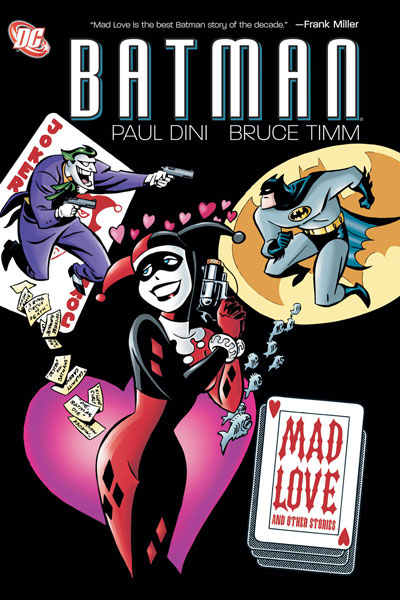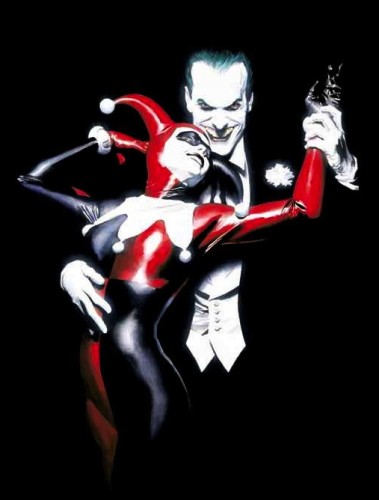
Our Bat-train keeps rolling on! We’re proud to bring you the fourth and final portion of chapter five of Jeremiah Lawson’s prodigious look at the moral and philosophical underpinnings of Batman: The Animated Series. I think it’s safe to say we’ve crossed over into unchartered territory…! To begin at the beginning, go here. To catch up on this particular chapter, which deals with those characters who occupy Gotham’s moral no-man’s land, go here.
PART FIVE: AT NIGHT ALL CATS ARE GRAY
D. The Weapon of Empathy: Harley Quinn in Gotham’s Depraved Duo
Empathy, unmixed with sympathy, can be a dangerous tool in the hands of someone who wants to hurt. … The true sadist is not lacking in empathy–on the contrary, empathy helps the sadist to derive maximum pleasure and inflict the greatest pain. – Roy F. Baumeister in Evil: Inside Human Violence and Cruelty. W. H. Freeman and Company. 1999. pp. 246-247
 The evildoer of popular imagination commonly laughs at the suffering of others, neither knowing or caring how the victim feels. Yet as psychologist Roy Baumeister notes, this may be the most significant misconception about cruelty in the myth of pure evil. Even serial killers do not kill when they are in the presence of uniformed police officers. They frequently choose victims whose disappearance may attract no notice until it is too late; they take great care to avoid getting caught. In other words, they have some capacity to imagine what others may think or feel, some degree of empathy–even if it’s only used to preserve their personal freedom.
The evildoer of popular imagination commonly laughs at the suffering of others, neither knowing or caring how the victim feels. Yet as psychologist Roy Baumeister notes, this may be the most significant misconception about cruelty in the myth of pure evil. Even serial killers do not kill when they are in the presence of uniformed police officers. They frequently choose victims whose disappearance may attract no notice until it is too late; they take great care to avoid getting caught. In other words, they have some capacity to imagine what others may think or feel, some degree of empathy–even if it’s only used to preserve their personal freedom.
Baumeister’s examination of sadism led him to conclude that we must distinguish between empathy and sympathy. The two may be used interchangeably, but the difference between them matters. If empathy is the capacity to imagine the thoughts and feelings of another person, sympathy is the capacity to express and share those thoughts and feelings. Empathy lets me imagine you missed an appointment because you lost your car keys. Sympathy is what prompts me to let you reschedule the appointment. Empathy untouched by sympathy may be the most horrifying weapon an abuser has. With this grisly idea in mind we turn our attention to the Depraved Duo of Gotham City, the Joker and Harley Quinn.
Harley Quinn is a rare beast. She made her debut as the Joker’s ditzy girlfriend in Batman: The Animated Series and only subsequently found her way into comics. Such was her charisma and chemistry with the Joker (and the Dark Knight). But Harlene Quinzelle (aka Harley Quinn) is easily misunderstood and underestimated. She is aware of this herself when she taunts, Batman in “Harlequinade” “See, do I know how Mr. J thinks, or what? Ha! And here you thought I was just another bubble-headed blonde bimbo. Well the joke’s on you, I’m not even a real blonde.” This self-incriminating put-down may sum up the paradox of Harley Quinn. She is ditzy and foolish yet if that was all she was Batman wouldn’t recruit her to help him stop Joker from destroying Gotham with an atomic bomb (“Harlequinade”) or try to help her adapt to normal life (“Harley’s Holiday”). Unlike the Joker, Batman believes Harley has a better nature to appeal to.
Yet the bubble-headed blonde bimbo proves to be a startlingly persistent foe for Batman. Harley is slender, athletic, genuinely sweet, and dazzlingly attractive. She’s also a trained clinical psychologist. One would imagine there would be no one better trained to recognize a sociopathic sadist than Harley. Yet time after time she is at the Joker’s side for his worst escapades.
 Many in Gotham have marveled that this woman would take up with the Clown Prince of Crime. Even the world’s greatest detective can’t solve the mystery of why this woman is drawn to the Joker. Quinn’s explanation itself doesn’t seem to make any more sense:
Many in Gotham have marveled that this woman would take up with the Clown Prince of Crime. Even the world’s greatest detective can’t solve the mystery of why this woman is drawn to the Joker. Quinn’s explanation itself doesn’t seem to make any more sense:
“Look Bats, when I was a doctor I was always listening to other people’s problems. Then I met Mr. J, who listened to me for a change and made everything fun.”
“Do you think it’s funny when he hurts people?” Batman asks.
“It’s just a joke.”
“Hope you’re still laughing when it’s your turn.”
Batman knows to expect the unexpected from the Joker, but he often underestimates Harley Quinn. This is even more true of the police in Gotham. Not once but twice does Harley Quinn walk straight into a police building and get things done for the Joker (see “Joker’s Favor” and “The Man Who Killed Batman”). She is a chameleon. But this is where it gets interesting: If Harley had a superpower it would likely be the empathy and sympathy that she can elicit or exhibit from/for others.
Before meeting the Joker these were the tools she used as a psychologist, after she meets him they become her most dangerous (and sneaky) weapons. In the episode “Harlequinade” we hear in a tossed off line that she considers men like Two-Face, Mad Hatter, Killer Croc, and the Ventriloquist friends! When she says hello to a raving Scarecrow in “Harley’s Holiday” the mad Dr. Crane suddenly stops and becomes warm and paternal toward her, as though she were a child or favorite pet. With a weird, childlike cruelty, Harley can also summon a childlike innocence brings out maternal instincts in Poison Ivy! In “House and Garden” we see in Ivy’s scrapbook that Harley’s friendship made the plant-loving villain realize how badly she wanted to have a family. If Harley is capable of bringing out the humane in remorseless killers like Poison Ivy why stick with Mr. J? Even Poison Ivy wants to know.
The answer is tragically revealed in “Mad Love“, one of the series most masterful episodes. We get to see Harley in her days as a psychologist. She admits to being drawn to the glamor of super-criminals and she buys Joker’s fabricated story about how he was abused by his father hook, line and sinker. We are shown that Dr. Quinzelle was lured in by the Joker’s promise to share with her his secrets. But she was also seduced by her naive belief that she could save the Joker and get a bit of glamor and fame along the way.
[youtube=http://www.youtube.com/watch?v=6_vtn_gv1QM&w=600]
But her gift for empathy and sympathy is a profound weakness as well. We get to see what she doesn’t, that Joker pegged her for hired help the minute she walked into Arkham Asylum (something Batman figured out quickly enough). What Harley doesn’t grasp, that Dini’s story shows, is that Harley Quinn is seduced by a fantasy that her empathy and sympathy can save anyone, even the Joker. What happens instead is the Joker seduces her at every level into joining him in his life of crime. Her mind Harley may grasp that Joker is a manipulative, murderous psychopath but her heart believed, even after he’s tried to kill her. Joker has taken her capacity for empathy and sympathy and warped them into weapons not only against his enemies but Harley herself, who can’t break free of his hold on her even when she sees him for what he is.
When Batman discovers Harley’s dream–that if she kills Batman she can settle down to a sweet domestic life with the Joker–he laughs at her. Harley stammers to the Dark Knight, “I’ve never seen you laugh before. I don’t think I like it.” Batman dismantles the illusion Harley has been harboring about a sweet life with Mr. J. Harley can’t accept that the weapons she’s been using against Batman and the people of Gotham have been used against her by the Joker. Her delusional belief that her love can save him is precisely what the Joker has used to imprison Harley. After years of telling Gotham “the joke’s on you,” the sickest–and most tragic–joke is ultimately on her.
[youtube=www.youtube.com/watch?v=-arMSdg82Ck&w=600]
Next up – the final chapter in our Bat-saga (for now), Crossing Thresholds: Apostasy and Salvation in Gotham City!

COMMENTS
Leave a Reply












